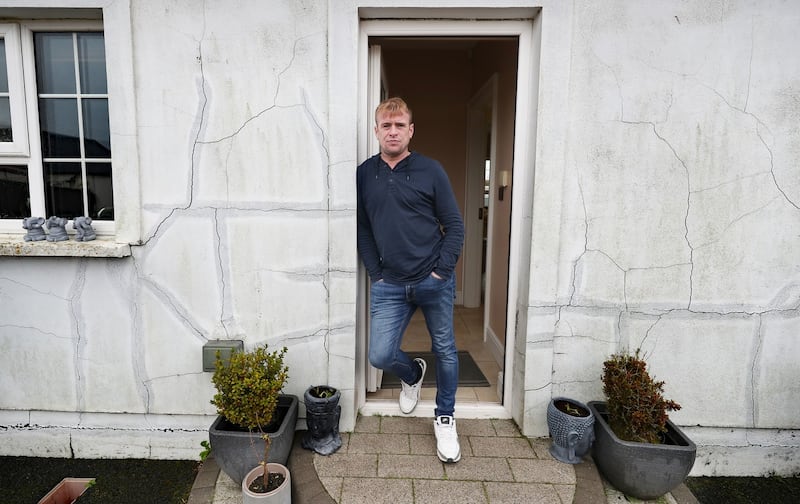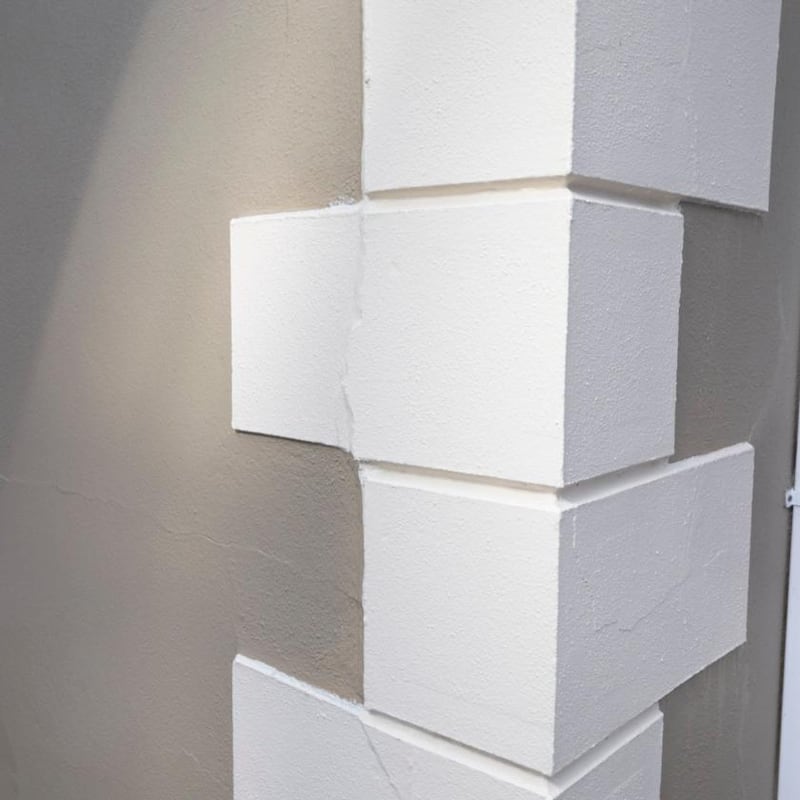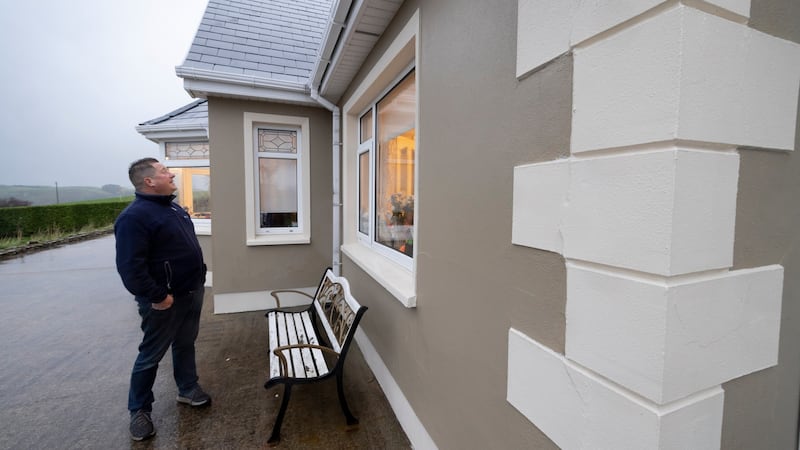The Inishowen peninsula in Donegal is a place of extravagant beauty. But driving along the road from Letterkenny north into the peninsula, the signs suspended on lamp-posts and the murals on the gable end of some buildings offer a stark reminder that all is not well beneath the vast skies and majestic landscapes. “100% redress,” the signs read. “Enough is enough.”
When you ask someone around here when the cracks first began appearing, it is not a metaphor. Ann Owens was one of the first to spot them spreading along the exterior walls of her house. “I noticed 10 years ago that my bungalow was cracking on the outside,” she says. Her insurance company sent out an engineer who was baffled.
In the early years, the discovery that your home had mica was often a source of shame
About the same time, further west in the county near Milford, Eamonn Jackson had a chartered surveyor out to look at an oil leak. He showed the engineer some hairline cracks in the gable end that he had initially attributed to settlement. He painted over them, but the cracks returned. The surveyor was able to fit a 1 cent coin into the crack. “He said, ‘I’m seeing this in other homes in the county, and I want to look into it a little bit more’.”
The first meeting for homeowners affected by the mysterious cracking was held in January 2013. “Sixty-three people turned up,” recalls Jackson. That night was the first time many of the homeowners heard the term “muscovite mica”, the naturally occurring mineral that has since been found in high quantities in blocks in many of the homes affected.
That was the first meeting at which some understood that their houses might have to be demolished. Shortly after, they would learn that their home insurance policies did not cover them for defective building materials.
In the early years, the discovery that your home had mica was often a source of shame. People “were embarrassed. They feared their neighbours would say, What are you doing? You’ll devalue our house,” says Jackson, who went on to become chairman of the Mica Action Group.
Now, says Louise Gibbons, Jackson’s neighbour, “it’s not a case of who has mica. It’s who doesn’t have it.”

Ann Owens reels off the people she personally knows who are affected. Her friend and fellow activist Eileen Doherty adds, “Literally, everywhere I look when I look out, I can see it.”
As one of the spokespeople for the campaign, who has given nearly 10 years to trying to get redress for the people of Donegal, Doherty is well used to talking about the issue. But she still becomes emotional when she thinks about the toll this has taken on her family. “I never wanted to spend the last 10 years of my life doing this,” she says tearfully.
*****
In 2001, Louise Gibbons and her husband, Sean, self-built a house outside Kerrykeel on an elevated site overlooking Mulroy Bay. It is a beautiful place for their three daughters, Ciara (16), Emma (13) and Aoife (8), to grow up. “It was the dream home. We worked hard ourselves and built it. We had no contractor. We got in our builders, our plumbers, our plasterers,” says Sean.
A decade or so ago, when the cracks first appeared, he painted over them. An optimist by nature, he reasoned that if he couldn’t see it, he didn’t have to think about it. “But the cracks just keep extending and getting bigger and more often. Now I’m filling and painting the cracks every year. If there’s a bad winter at all, it really speeds it up a lot.”
The cracks have recently begun appearing inside too. The side of the house where 13-year-old Emma sleeps has been deemed critical. “We have a crack inside Emma’s bedroom and in her wet room,” Louise says.
The house has been recommended for outer leaf and inner leaf replacement, which means everything will have to go except for the roof and internal walls. Finding somewhere else to live is not going to be easy for any of the affected families, but for the Gibbons it will be especially challenging. Emma has intellectual, motor and physical disabilities and is in a wheelchair. She is due to have surgery soon to have multiple metal rods removed from her spine.
“You’re coming with a lot more baggage. You’ve got wheelchairs and hoists and shower seats,” Louise says.
*****
Last week, the Gibbons were among thousands of others – organiser Paddy Diver puts the figure at 20,000 – who descended on Dublin to protest about the limitations to the redress scheme to be offered to the 6,600 homeowners in Donegal and Mayo affected.
Campaigners have been calling for 100 per cent redress, a State-backed guarantee scheme for anyone who has remedial work carried out on mica-affected homes, and a raising of the proposed €350,000 cap.

Diver has worked in construction all his life, but he had never heard of mica until it came to his town, Carndonagh. Now, he has become something of a folk hero for the movement. Several people tell me it was his campaigning on the issue that made it acceptable to talk about having mica.
A friend who helps run his social media describes how people come to Diver to ask for a selfie. At one of the houses I visit with him in Donegal, there is a mural painted on the gable end featuring Diver’s scowling face.
The current defective concrete blocks grant scheme costs about €7,000 just to get the initial assessments done. Any scheme offering less than 100 per cent redress will leave him and many others in Donegal behind.
“I haven’t a hope of being able to afford it. No banks will give me money. No credit unions will give me money. The 90-10 scheme was a farce from day one. What kind of message is it to send out that we’ll leave old-age pensioners behind?”
Minister for Housing Darragh O’Brien has promised the redress scheme will be significantly enhanced. A spokesman told The Irish Times that “the current scheme introduced by the previous government is not working in the manner in which it was intended”.
There were suggestions on social media that this is about homeowners demanding a brand new, State-funded home – or 'McMansion' as some snidely put it
Initially, the public response to homeowners was one of widespread sympathy. More recently, campaigners detect a range of other reactions creeping in, including some questions about whether it’s fair to expect the State to pay for 100 per cent of the costs. Others wonder who else can be made to pay.
There were suggestions on social media that this is about homeowners demanding a brand new State-funded home – or “McMansion” as some snidely put it. Others questioned where the figure of €3.2 billion for redress comes from and just how big the bill might get if other counties are impacted.
Many of “these are reasonable questions”, says Eileen Doherty. “They’re questions we asked too.” The answers, like the geology of Donegal, are not straightforward.
*****
“Donegal is a world-renowned destination for structural geologists” because of its rich and complicated geology, the 2017 expert group report on the mica issue found. About 20 quarries were operating in the county in the early 2000s, of which six were producing from metamorphosed fine-grained sedimentary rock, which is likely to consist of “varying proportions of quartz/feldspar/mica”.
The Gibbons, Owens, the Dohertys, Jackson and many of the other affected families all sourced their blocks from the same place: Cassidy Brothers, a family-run construction firm based in Donegal.
“You had to buy the best, and the best was Cassidys. Forget about anybody else. They had the reputation,” says Jackson. Others, including Owens, recall tradespeople saying they liked using Cassidys’ blocks because they were easy to work with.
As you drive through Donegal, it seems the firm is not held in the same affection as it once was. Alongside the signs calling for “100% redress” are others calling for a boycott of Cassidys, which supplied the materials for 80-90 per cent of the homes built during the 1990s and early 2000s.
Cassidy Bros is still in operation from its quarry at Buncrana. Its website still offers a range of prices for concrete blocks, although it is no longer, a source said last week, producing blocks for housing construction. This is not because it’s not permitted to but because demand has been impacted by negative publicity, which has also taken a toll on the family that owns the company and its employees.
*****
Cassidy Bros, in previous public statements, has pointed out that it always adhered rigidly to building standards set down by government. It said it had a full on-site laboratory and completed required tests, which were independently audited regularly. It was, it has stated, “as shocked as everyone else when damage emerged in properties”.
Cassidy Bros has said on more than one occasion that it fully backs families in their campaign for 100 per cent redress from the Government. “The failure in standards has failed all of us.”
Cassidy was invited on Tuesday to be interviewed for this article, but asked that we submit questions in writing instead. It did not reply to these, telling The Irish Times on Thursday it had been given insufficient time to do so.
On Friday morning, The Irish Times received a letter from Edmond J Dillon solicitors, acting for “Cassidy Bros. Concrete Products Ltd., Cassidy Bros. Topmix Ltd., David Cassidy, Denis Cassidy, Seamus Cassidy and Natasha Cassidy.”
It includes the statement: “We and our clients only too well understand and appreciate the anger and concern that exists in Donegal, and indeed throughout the State generally, in relation to masonry blocks that are demonstrating issues.”
The letter – addressed to this journalist – also says: “You have spent a number of days in north Donegal meeting and engaging extensively with, inter alia, members of the Mica Action Campaign and the 100% Redress Group” but “never made contact with our clients when you were in County Donegal, never sent the said queries to us at an earlier stage.”
It says that some of our questions are “predisposed to certain answers” and says the time provided to answer them was “unreasonable and unfair”.
The letter also includes the statement: “You will be well aware that we, on our clients’ behalf, have had to write to several broadcast and print media outlets arising from articles and broadcasts that have been published by them on foot of information provided by some of the persons whose homes have been adversely affected by issues with their masonry blocks. As a consequence, many of the said broadcasts and publications have been removed from the respective platforms.”
The letter further states that Cassidy has “written a very detailed letter, with extensive enclosures, to the Mica Action Group”.
*****
So who is responsible for setting building materials standards and ensuring they are met?
Since 2013, European Union regulations governing the quality of building materials are overseen by local authorities, who are the “principal market surveillance authorities for construction products”.
In practice, however, the system still relies largely on self-regulation. In order to use a CE mark on their product, “manufacturers must test and declare the performance of their construction products using a common technical language”, a spokesman for Minister for Housing Darragh O’Brien said last week.
The National Standards Authority of Ireland (NSAI) has produced what is called “additional guidance” in the form of “standard recommendations”, which set out minimum performance levels for construction product manufacturers.
We shouldn't be relying on 19th century law to protect you. If there's a problem with your house, we should recognise that it's your home
Since 2021, Ireland’s National Market Surveillance programme has given Dublin City Council’s National Building Control Office powers to perform inspections countrywide on quarries and pit operations. It’s not clear, however, how often such inspections are carried out. And so nobody can say with certainty that all of the building materials being produced in Ireland are up to the required standard, or that this could never happen again.
“We have a really significant problem with regulatory enforcement in Ireland,” says barrister and construction law expert Dr Deirdre Ní Fhloinn. She points out that defective building materials are not just covered by EU regulations but by existing consumer laws, including the Sale of Goods Act 1893.
Other experts cite a law that came into effect in 1949 (S.I. 288 1949) that regulates the amount of harmful impurities permitted to be present in blocks. It sets the limit for mica at 1 per cent.
The law is there “but what’s not there is any obligation to insure against defects” in those products, says Ní Fhloinn. “We have a patchwork of legal rules [but] they don’t add up, and they don’t provide a coherent route to remedy for homeowners.
“We shouldn’t be relying on 19th-century law to protect you. If there’s a problem with your house, we should recognise that it’s your home... The State will always be the ultimate insurer of people’s homes if we don’t take steps to hold the private sector liable in respect of what they built, both by regulation and by providing effective remedies.”
*****
How confident can we be that this can never happen again? The answer to this question is complicated by the fact that not everyone can agree on the process that caused the homes in Donegal and other counties to begin crumbling, or the best way to remedy.
Last week, a source close to Cassidy Bros questioned the belief that mica is responsible, calling the focus on the mineral an over-simplification. Instead, the source suggested the damage is caused by the effect of “freeze-thaw action” on blocks with a compression strength of 5N (N stands for Newton, a measurement of concrete strength). The required standard until 2013 was 5N, when it was increased to 7.5N. Cassidys believed this standard was not high enough and says it voluntarily increased the strength of its blocks in 2011 as a precaution to 10N by increasing cement content.

Other experts, however, remain convinced that the high presence of mica – a glassy, flaky, brittle mineral mined in Russia for panes of glass and also found in the Wicklow mountains and Liscannor – in the blocks is implicated.
Mica, says structural engineer Dr Ambrose McCloskey, is “a known deleterious mineral. It absorbs a lot of water and this causes issues, particularly when frozen, and is very susceptible to freeze-thaw.”
In some countries, such as Switzerland, mica is permitted to make up to 5 per cent of the quantity of concrete without any special measures. Higher than that, manufacturers must be able to show that they can reach a “targeted concrete quality”. In one engineer’s report for an affected home, seen by The Irish Times, the level of free mica is found to be 14 per cent.
Campaigners point out that other deleterious materials have been found in affected homes, including pyrite and pyrrhotite. These are iron sulphides which produce sulphuric acid when they get wet. Pyrrhotite has been implicated internationally in the deterioration of houses in Connecticut. But once again, there is no clear consensus on what factor these components may have contributed to the damage.
*****
Without answers to these questions, some experts argue we can’t say for sure whether proposed remedial measures will be enough. A scale of remedies is offered under the IS 465 protocol, from minor remediation to demolition.
“Realistically, these remedial options are not a long-term fix,” says McCloskey. “You’re only taking down the blockwork that’s visible today and replacing it. But the blocks that are in the ground and the blocks that are internally in your house are highly micaceous and subject to moisture in the ground.”
If an engineer makes an assessment based on current damage levels that outer leaf replacement is enough, what happens in five years’ time, he asks, if cracks start to appear elsewhere in the house?
Ann Owens offers a cautionary tale. She replaced her own outer leaf at a cost of €20,000. “I got a really good job done. After four years, the inside walls of my house are cracking. I used to watch the outside of my house cracking. Now I’m watching the inside of my home crumbling.”
There's families not coping at all. There's been separations. There's been divorces. There are people with mental health issues. There's pensioners taking sleeping tablets to get to sleep. There's pensioners waiting for emergency accommodation
What is incontrovertible is that homes in Donegal, Mayo and other counties – Sligo estimates it could have as many as 160; Limerick county council told The Irish Times it is aware of 20 possible instances of defective materials – are crumbling.
Insurance companies have walked away.
The firm that supplied most of the building materials during the housing boom in Donegal says it is not to blame and that it always adhered to the standards.
The banks who mortgaged the homes that are now worthless and uninsurable have not offered any redress – though mortgages must still be paid and they will benefit if the State pays to have the homes rebuilt.
Homeowners have been left with no recourse but to turn to the State.
*****
A spokesman for the Minister for Housing said last week:
“Minister O’Brien has always said it is his intention to pursue those responsible as well as potential stakeholders. It is his belief that those who are legally responsible should contribute towards remediation. He has engaged intensively with the Attorney General on this matter and he is working on mechanisms to ensure wrongdoing and liability on the part of quarries and other parties are fully penalised. It is a complex matter, but... efforts to pursue those responsible will not delay the bringing forward of an enhanced scheme.”
Campaigners say they have been hurt by suggestions they live in “mansions” that they now expect the taxpayer to rebuild. They point out that the average house size in the county is 2,400sq ft, and they dispute the €3.2 billion figure given for rebuilding costs.

“I still have not met anyone yet who has said, ‘Thank God, I’m going to get a brand new house, and all I have to do is pay €60,000 on top of it’. I don’t know anyone who’s happy with this,” says Paul Dunlop, professor of glaciology and research director for geography and environmental sciences at Ulster University, and also an affected homeowner.
“We bought this house to live in it for the rest of our life. We don’t live in a mansion. We live in a housing estate.”
Contrary to reports that homeowners are looking for new kitchens, windows and internal doors, Diver says he and others will reuse what they can.
“There’s families not coping at all,” says Paddy Diver. “There’s been separations. There’s been divorces. There are people with mental health issues. There’s pensioners taking sleeping tablets to get to sleep. There’s pensioners waiting for emergency accommodation.”
“It is a slow-moving earthquake,” says Eamonn Jackson. “Everything is crumbling in slow motion. If an earthquake was to happen in Donegal, and 7,000 homes were all affected and some collapsed and many were cracked, the Government would be sending people from all areas of the country to help.”





















